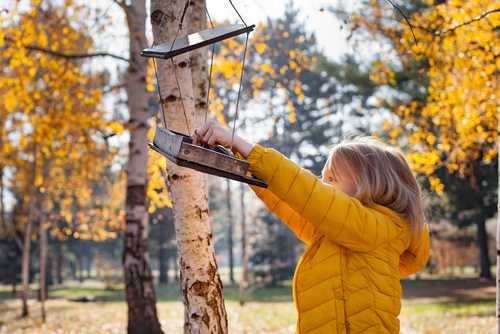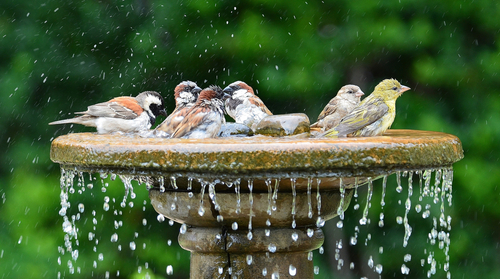Welcome Birds to the Garden
Of all the wildlife that visits our gardens, birds are often the most welcome. Not only are their antics at the feeders amusing, they're also gobbling up hundreds of pesky insects each and every day. It's not difficult to accommodate our feathered friends; they're happy with the simple basics of food, shelter, and clean water. And no matter how small an area you have, you can make it a refuge for birds.
Plan Ahead
Decide first which species of birds you want to attract, then offer the kinds of food those particular birds prefer. You can hang bird feeders in your garden or add plants to create a natural source of food -- or both! You'll find that some birds are bold and others are shy; some feed on the ground, some come to any feeder, and others prefer the seclusion of trees. You'll attract the widest variety of birds by incorporating all of these elements into your garden.
Provide Cover
 Birds need shelter to protect them from the elements and allow them to hide from predators. Dense, twiggy shrubs and evergreens are the shelter of choice for most birds, but deciduous ornamental trees, shrubs, vines, and ground covers, as well as flowering annuals and perennials, can all provide food and protection. Berry-producing trees and shrubs are most popular avian hangouts. Favorites include cotoneaster, barberry, euonymus, dogwood, huckleberry, and viburnums of all kinds.
Birds need shelter to protect them from the elements and allow them to hide from predators. Dense, twiggy shrubs and evergreens are the shelter of choice for most birds, but deciduous ornamental trees, shrubs, vines, and ground covers, as well as flowering annuals and perennials, can all provide food and protection. Berry-producing trees and shrubs are most popular avian hangouts. Favorites include cotoneaster, barberry, euonymus, dogwood, huckleberry, and viburnums of all kinds.
Hang Feeders
Depending on the types of birds you're trying to attract, you'll probably need to provide different types of food. For example, finches eat seeds, woodpeckers look for nuts, and hummingbirds want nectar. Just as birds eat different types of food, they also prefer different styles of bird feeders. Some are designed to attract a specific bird, such as the finch feeder and oriole feeder. Ground-feeding birds will come to a flat platform feeder, and there are feeders designed for smaller birds. For the greatest variety and number of birds, try a variety of feeding spots and feeders. Start with one or two feeders and increase the number as you learn which foods and feeders the birds prefer.
Entice with Water
 Water is vital for birds throughout the year so a reliable source should be part of your backyard habitat. Ideally, the water source should be about 3 inches deep and 3 feet off the ground. Motion and sound will attract a bird's attention. Try suspending a leaky bucket from a branch over a birdbath to provide just enough sound to interest the most timid of birds.
Water is vital for birds throughout the year so a reliable source should be part of your backyard habitat. Ideally, the water source should be about 3 inches deep and 3 feet off the ground. Motion and sound will attract a bird's attention. Try suspending a leaky bucket from a branch over a birdbath to provide just enough sound to interest the most timid of birds.
If you spend a little time planning, you'll soon have birds flocking to your backyard! Then you can get out your field guide and your binoculars and join the 20 million other Americans who enjoy the rewarding hobby of bird-watching.
Read more from The National Gardening Association.








